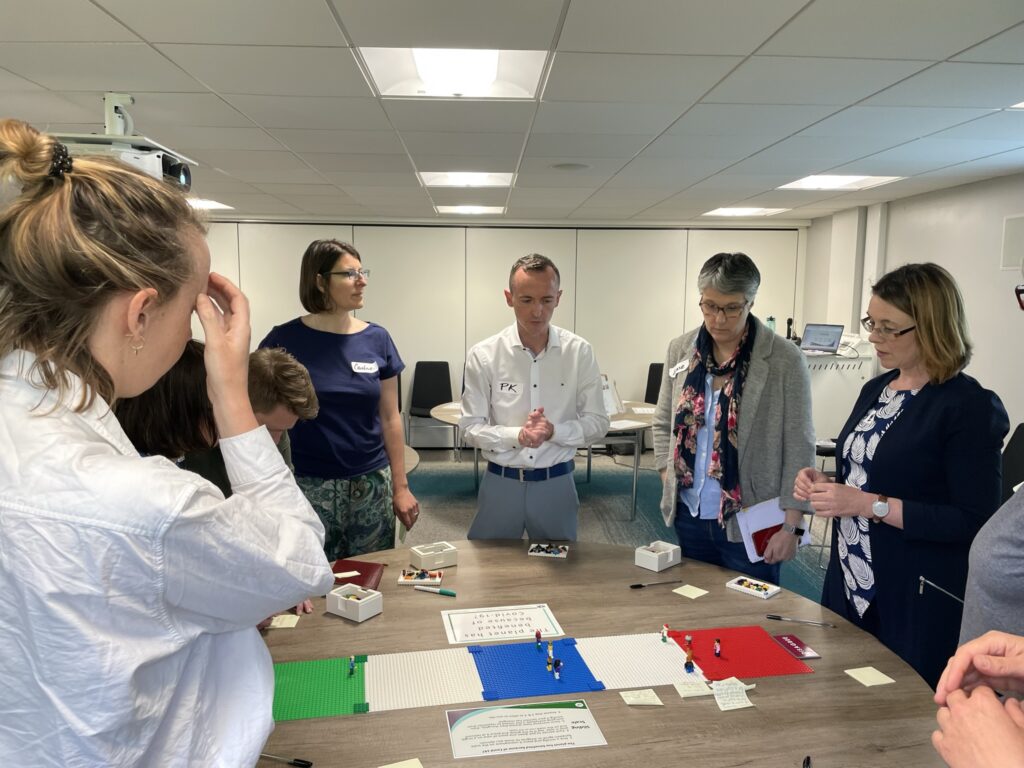Explaining the science of LEGO® Serious Play® and its benefits
Ah LEGO, that familiar old toy with the colourful bricks. It probably provided you with …

Ah LEGO, that familiar old toy with the colourful bricks. It probably provided you with …
You probably already have a general idea of the importance of team alignment in a …
Have you ever wondered how to create a team vision statement to map out your …
In our last article we examined the difference between a vision statement and mission statement. …
For the last few months, our blog posts have focused on how you can improve …
Are you new to a leadership role? Well worry not, we have seven tips to …
In the world of business, leadership is one of the most important components to creating …
The chance is that if you are interested in this series, you are probably already …
In a recent article published by the BBC, author Bryan Lufkin talks about the ripple …
The best cultures are the ones where the company values fit the organisation’s vision and …
Are you new to a leadership role? Well worry not, we have seven tips to improve leadership and have collated them into this nice and succinct article! This is the last of our posts on leadership, so if you are looking for more insight into this topic, head over to the blogs section of our website. For now, here are our top tips to improve your leadership!
Being a leader is like being a parent. At first, the job is totally new and probably quite challenging, but you have to keep learning and growing in your role. There is no one-size-fits-all, pre-formulated pill to effective leadership. Instead, consider some of the following tips to improve leadership and think about implementing these strategies in your daily life.
Humility is the quality of having a modest view of one’s importance. For example, a leader with humility is often comfortable crediting others for their contributions at work. It also means that the best ideas are championed, regardless of whether the concept has originated from higher management or not. By remaining humble, you are more likely to have effective team meetings, as employees will know that their ideas will be acknowledged.
With so much focus on customers, we often lose sight of our employees and the critical roles in our organisations. It’s always instructive to remember that organisations are the employees. As a result, customer service and quality are dependent on these skilled, motivated people. Invest some time in your employees, and you should see a return on these investments.

The third of our tips to improve leadership is crucial for running effective meetings and increasing employee engagement. Exercising leadership often means articulating your vision and inspiring people to rally around it. Always keep in mind that it is the passion for the work that binds you and your employees. Leaders should have a genuine passion and enthusiasm for the projects they work on. As a leader, you have to represent what you expect from the people who work alongside you. You can develop this leadership quality by thinking of different ways that you can express your zeal. Let people know that you care about their progress. It is much easier for employees to be engaged in their work when their development is being acknowledged. When someone decides to share something with the rest of the group, tell them how much you appreciate such contributions.
Take the initiative and try to anticipate problems. Offering effective recognition and rewards are some of the best ways to help followers feel appreciated and happy. As a result, this can increase employee engagement as people recognise that their work will be rewarded. That said, if your business encounters any issues, don’t wait for others to resolve the matter for you. As a leader, you are expected to be there to handle difficult situations. There are multiple ways you can do this, though. For example, you could resolve an issue yourself, or you could contact someone external to carry out a problem solving workshop.
Leave no room for frustration in your business. You must be available for your team and make them feel comfortable sharing their problems with you if necessary. By keeping your door open and inviting dialogue, you can create a healthy climate of trust that promotes the flow of ideas. Communication is and will always be the key to great teamwork – we see this all the time in meeting facilitation. Don’t place yourself on a pedestal by closing yourself off to criticism and new ideas.

As a leader, the learning process should be continuous. You can work it into your daily routine, whether that be by watching the news, reading the paper or picking up an informative read in your local bookshop. Take stock of everything you have learned during your ascent to leadership.
The last of our 7 tips to improve leadership is reflecting. Working on self-awareness is the basis of emotional intelligence. Having a clear picture of your strengths and weaknesses will better prepare you and your team for specific tasks. Often, we judge ourselves more favourably than others. Consider what you once expected from your superiors, how they could have improved and what did or didn’t motivate you to follow them. Then, write all this down and pinch those qualities you consider essential. It is necessary to have one or more sources of inspiration. Tap into people you admire and who are models of leadership for you.
Of course, this is not an exhaustive list of tips to improve leadership but merely a start. How you work with others can be influenced by many factors and restraints. Ultimately, it is down to you to know the balance, but always keep in mind the above points.
In our next series, we will be looking at the role of the Vision Statement, so make sure to keep an eye out on our social media for any news of that.
FOR INQUIRIES, PLEASE EMAIL US AT [email protected] OR
BOOK A FREE 30-MINUTE CONSULTATION AT HTTPS://PANDEK.ORG/.
If you would like to hear more about events, offers, blogs and newsletters CLICK HERE.
We understand that each company’s situation is unique. Tell us more about your needs and challenges and we will get back to you soon with some ideas, or book a free conversation and begin your journey.
COPYRIGHT © 2024 PANDEK GROUP LIMITED - ALL RIGHTS RESERVED - COMPANIES HOUSE - 12467210 - Operating across the UK - Based in the South West